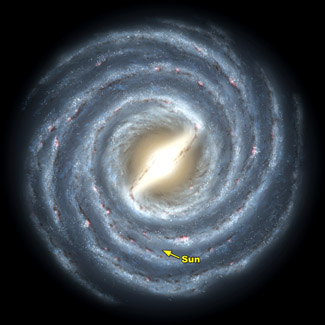 Giants
of space Giants
of space
When
you talk about outer space, the most obvious, yet breathtaking thing
about it is the size of the objects in it. Among these hulks of space,
there are a set of members who are way in front in the ranking by
magnitudes. Let's see what these giants are and how they stand
significant in the vast Universe.
Stars
Stars are easily recognisable in the night sky due to their twinkling
nature. Scientifically, a star is a huge glowing ball of hot gases, comprising mostly hydrogen and helium.
huge glowing ball of hot gases, comprising mostly hydrogen and helium.
There are many different types of stars ranging in size, colour,
temperature and brightness. Stars reside very far from Earth at
distances probably too far for humans to travel in a lifetime.
Therefore, much of what we know about stars is learned through studying
the light of the star, which is known as spectral analysis.
For example, the colour of a star gives us information about its
temperature much in the same way that the colour of a candle's flame
tells us which parts of that flame are hotter.
The closest star to Earth is our Sun, which is a yellow star. Yellow
stars have an average temperature of about 6000 (K). In terms of size,
the Sun is an average star, which is about 4.7 billion years old.
Nebulae
Nebulae are clouds of gas and dust particles spread out through
interstellar space. Some time back, many objects seen in the Universe
other than planets and comets were considered as nebulae.
The reason for this is that before telescopes were developed
sufficiently, in order to clearly 'see' the objects in space, all
objects, with even a slightly unclear or fuzzy appearance, were thought
of as neblae. Many of these objects are now identified as galaxies and
star clusters with the advancement in science and technology.
There are several types of neblae such as emission nebulae,
reflection nebulae, dark nebulae, planetary nebulae and so on.
Emission nebulae are
clouds of high temperature gas. The atoms in the cloud are energised by
ultraviolet light from a nearby star and emit radiation as they fall
back into lower energy states. These nebulae are usually red.
Reflection nebulae are
clouds of dust which are simply reflecting the light of a nearby star or
stars. They are usually blue because the spreading is more efficient for
blue light. Reflection nebulae and emission nebulae are often seen
together and are sometimes referred to as 'diffuse nebulae'.
Dark nebulae are clouds of
dust which are simply blocking the light from whatever is behind. They
look different only because of the geometry of the light source, the
cloud and the Earth.
Planetary neblae are nebulae that when viewed through a small
telescope can look very similar to planets.
Star clusters
As the name implies, star clusters are groups of stars in a cluster.
Then the next question you would ask would be; why are they clustered
together? The answer is that this happens when these stars are held
together by their mutual gravitational attraction.
There are two types of star clusters which are visible in our Milky
Way Galaxy; open clusters and globular clusters. Open clusters typically
contain dozens to hundreds of stars, many of which are bright, young,
and blue.
Open clusters, which are
also called 'galactic clusters' are collections of dozens or hundreds of
young stars many of which are bright and blue. They are generally not
gravitationally bound and will separate in a relatively short period of
time.
 Globular
clusters are gravitationally bound groups of many thousands
or sometimes as many as a million stars. Globular
clusters are gravitationally bound groups of many thousands
or sometimes as many as a million stars.
They consist primarily of very old stars. There are several hundred
globular clusters associated with our galaxy. A typical open cluster is
less than 50 light-years across, whereas a typical globular cluster is a
few hundred light-years across.
Galaxies
Galaxies are enormous structures made up of stars, gas, and dust held
together by the gravitational attraction between each of them. Small
dwarf galaxies may contain several million stars while the larger ones
will have up to trillions of stars.
Until recently, galaxies were thought to be nebulae within our own
stellar neighbourhood. However, Edwin Hubble's study of the Andromeda
Galaxy in the 1920s revealed about galaxies far away to us.
Pictures taken in 1996 by the Hubble Space Telescope have helped
estimate the number of galaxies to be about 50 billion. Our own Milky
Way galaxy is just one of the billions of galaxies now known to exist. A
typical galaxy is 100,000 light-years in diameter.
There are few types of galaxies such as 'spiral', 'lenticular',
'elliptical' and 'irregular'.
Spiral galaxies are organised in a spiral formation. Our Milky Way is
the perfect example for this. Lentiucular galaxies are 'spiral' galaxies
without spiral structure', which means that they are smooth disk
galaxies, where stellar formation has stopped long ago. Elliptical
galaxies are actually of ellipsoidal shape.
Aravinda
Dassanayake |
